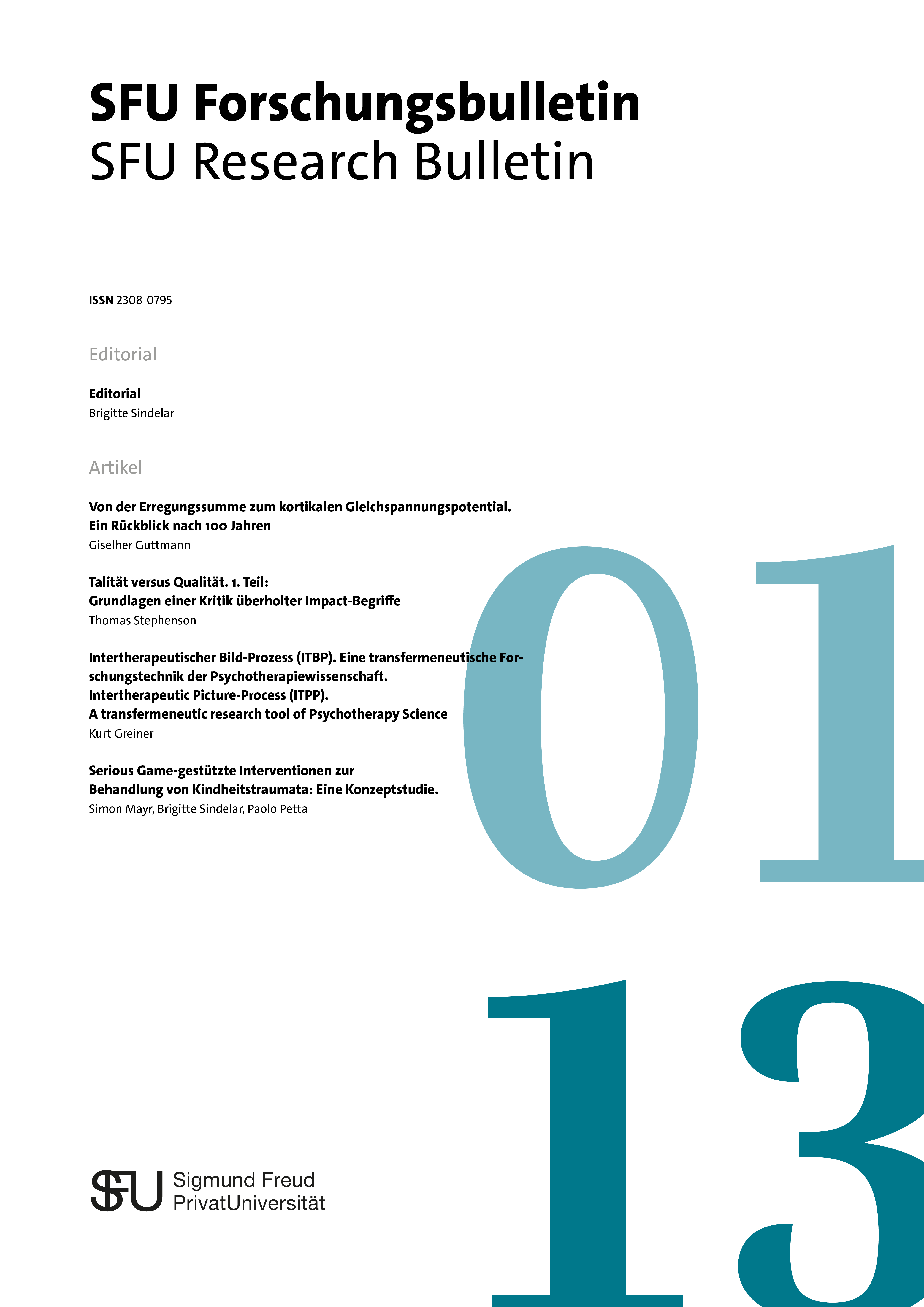Von der Erregungssumme zum kortikalen Gleichspannungspotential. Ein Rückblick nach 100 Jahren
DOI:
https://doi.org/10.15135/2013.1.1.4-15Abstract
Sigmund Freuds zentrales Interesse galt, nachdem er im Jahre 1873 in Wien sein Medizinstudium aufgenom-men hatte, viele Jahre hindurch der Physiologie, die er am Institut von Ernst von Brücke kennenlernen konnte. Einen nachhaltigen Einfluss übten auf ihn die Ideen von Josef Breuer aus, der das Modell einer „intrazerebralen tonischen Erregung" entwickelt hatte. Ein Jahrzehnt hindurch waren die wissenschaftlichen Arbeiten Freuds ausschließlich der Neurohistologie und der klinischen Neurologie gewidmet.
Ganz unerwartet erscheint jedoch im Jahr 1894 die Arbeit: „Die Abwehrneuropsychosen. Versuch einer psycho-logischen Theorie der akquirierten Hysterie, vieler Phobien und Zwangsvorstellungen und gewisser halluzinato-rischer Psychosen". In ihr werden für die Konsequenzen von emotionalen Belastungen kühne Erklärungen ge-geben, die überhaupt nicht im Geist der bisherigen Arbeiten Freuds zu liegen scheinen. Am Ende dieser Publi-kation macht er jedoch eine bemerkenswerte Feststellung: Er habe sich einer Hilfsvorstellung bedient, der zufolge es eine „Erregungssumme" gäbe, die sich „… über die Gedächtnisspuren der Vorstellungen verbreitet, etwa wie eine elektrische Ladung über die Oberflächen der Körper. Man kann diese Hypothese ... in demselben Sinne verwenden, wie es die Physiker mit der Annahme des strömenden elektrischen Fluidums tun."
Diese Annahme ist aus neuropsychologischer Sicht eine prophetische Feststellung, da wir ein Jahrhundert spä-ter tatsächlich in der Lage sind, kortikale Oberflächenpotentiale zu erfassen, die Ausdruck der lokalen Erregbar-keit und Reaktionsbereitschaft sind und der „Erregungssumme" zu entsprechen scheinen. Die vorliegende Publikation, in der die Brücke von Freud zur modernen Neurowissenschaft geschlagen wird, ist die deutsche Fassung des Vortrags „From the Sum of Excitation to the Cortical DC Potential. Looking back a Hundred Years", den ich seinerzeit auf einem an der Akademie der Wissenschaften veranstalteten Symposium gehalten habe. Es war dem neurologischen Frühwerk Freuds gewidmet und ist in Englischer Sprache in der Monographie „Freud and the Neurosciences" erschienen (Guttmann, 1998).
Literaturhinweise
Bacher, R. (1992). Libidometrie. In: Fallend & Reichmayr (Hrsg.): Siegfried Bernfeld oder die Grenzen der Psychoanalyse. Basel, Stroemfeld/Nexus.
Barolin, G., Gidon G. & Giselher G. (1968). The effects of hypnotic suggestions on the acoustic evoked potential. EEG clin. Neurophysiol., 24.
Bauer, H., Ch. Rebert, Ch. Korunka & M. Leodolter (1997). Rare events and the CNV – the oddball CNV. International Journal of Psychophysiology, 13, 51-58.
Bauer, H. (1998). Slow potential topography. Behavior Research Methods, Instruments, & Computers. , 30 (1), 20-33.
Berger, H. (1929). Über das Elektroencephalogramm des Menschen. 1. Mitteilung. Archiv Psychiatrisches Nervenkrankenhaus, 87: 527-570.
Bernfeld,l S. & Cassierer Bernfeld, S. (1988). Bausteine der Freud-Biographik. Frankfurt am Main, Suhrkamp-Taschenbuch Wissenschaft.
DuBois-Reymond, E. (1918). Jugendbriefe an Eduard Hallmann. (Hrsg. E.DuBois-Reymond). Berlin.
Fechner, G. T. (1889). Elemente der Psychophysik. Leipzig: Breitkopf & Härtel.
Freud, S. (1877). Über den Ursprung der hinteren Nervenwurzeln im Rückenmarke von Ammocoetes (Petromyzon Planeri) S.B. Akad. Wiss. Wien (Math.-Naturwiss. Kl.), III. Abt., Bd. 75, 15-27.
Freud, S. (1884). Ein Fall von Hirnblutung mit indirekten basalen Herdsymptomen bei Skorbut. Wien. Med. Wschr., Bd. 34, Nr.9, 244-246, und Nr.10, 276-279.
Freud, S. (1886). Akute multiple Neuritis der spinalen und Hirnnerven. Wien. Med. Wschr., Bd. 36, 168-172.
Freud, S. & Breuer, J (1893). „Über den psychischen Mechanismus hysterischer Phänomene; Vorläufige Mitteilung. G.W., Bd. 1, 81-98.
Freud, S. & Breuer, J (1895). Studien über Hysterie. Wien. [Vollständige Neuausgabe als Taschenbuchausgabe, Frankfurt a.M., 1979, Bd. 1, 77-312).
Freud, S. (1894). „Die Abwehrneuropsychosen. Versuch einer psychologischen Theorie der akquirierten Hysterie, vieler Phobien und Zwangsvorstellungen und gewisser halluzinatorischer Psychosen“. Neurologisches Zentralblatt, Nr. 10 und 11.
Guttmann, G. (1968). Evoziertes Potential und Erleben. In M. Irle (Hrsg.), Bericht des 26. Kongresses der Deutschen Gesellschaft für Psychologie, S. 189-195. Göttingen: Hogrefe.
Guttmann, G. & Bauer, H. (1982). Learning and information processing in dependence on cortical DC-potentials. In: R. Sinz. & H. Rosenzweig (Hrsg.). Psychophysiology 1980. Jena: Fischer & Elsevier.
Guttmann, G. & Bauer, H. (1984). The Brain Trigger Design: A powerful tool to investigate Brain-Behavior-Relations. In R. Karrer, J. Cohen & P. Tueting (Eds.), Brain and Information: Event Related Potentials. Annals of the New York Academy of Sciences, 425, 671-675. New York: New York Academy of Sciences.
Guttmann, G. (1992). Zur Psychophysiologie des Bewußtseins. In: G. Guttmann, und G. Langer, (Hrsg.) Das Bewußtsein. Multidimensionale Entwürfe. Wien: Springer.
Guttmann, G. (1995). Psychophysiology of hypnosis and other altered states of consciousness. In: Hypnosis connecting disciplines. Wien: Med.Pharm.Verlagsgesellschaft.
Karl H. Pribram: Languages of the brain. Experimental paradoxes and principles in neuropsychology. 1971, Englewood Cliffs, NJ: Prentice Hall.
Rohracher, H. (1935). Die gehirnelektrischen Erscheinungen bei geistiger Arbeit. Zeitschrift für Psychologie, 136, 308-324.
Rohracher, H. (1937a). Die gehirnelektrischen Erscheinungen bei Sinnesreizen. Zeitschrift für Psychologie, 140, 274-308.
Rohracher, H. (1937b). Die gehirnelektrischen Erscheinungen bei verschiedenen psychischen Vorgängen. Pontificia Academia Scientiarum „Commentationes“, 1, 89-133.
Rohracher, H. (1940). Die elektrischen Vorgänge im menschlichen Gehirn. Zeitschrift für Psychologie, 149, 209-279.
Vitouch, O., Bauer, H., Gittler, G., Leodolter, M. & Leodolter, U. (1997). Cortical activity of good and poor special test-performers during spatial and verbal processing studied with Slow Potential Topography. International Journal of Psychophysiology, 27, 183-199.
Gray, W., Cooper, R., Aldridge, V. J., McCallum, W. C. & Winter, A. L. (1964). Contingent negative variation: an electric sign of sensorimotor association and expectancy. Nature, 203: 380-384.
